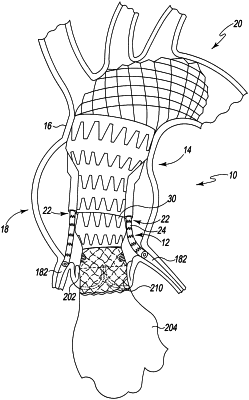| CPC A61F 2/856 (2013.01) [A61F 2/07 (2013.01); A61F 2/2418 (2013.01); A61F 2/82 (2013.01); A61F 2/962 (2013.01); A61F 2002/061 (2013.01); A61F 2002/067 (2013.01); A61F 2/24 (2013.01); A61F 2/86 (2013.01); A61F 2/89 (2013.01); A61F 2/90 (2013.01); A61F 2210/00 (2013.01); A61F 2210/0014 (2013.01); A61F 2210/0057 (2013.01); A61F 2220/0008 (2013.01); A61F 2220/0016 (2013.01); A61F 2220/0025 (2013.01); A61F 2220/0058 (2013.01); A61F 2220/0075 (2013.01); A61F 2230/001 (2013.01); A61F 2230/0034 (2013.01); A61F 2230/0067 (2013.01); A61F 2250/0039 (2013.01); A61F 2250/0048 (2013.01); A61F 2250/0069 (2013.01)] | 9 Claims |

|
1. A prosthesis assembly, comprising:
an endovascularly delivered main body that defines a stent frame and a graft material portion at an outwardly tapering section of the main body, wherein the graft material portion is at a distal position of the prosthesis assembly,
wherein the main body defines a longitudinal axis extending through a length thereof;
a valve housing at a proximal position of the prosthesis assembly, the valve housing including a prosthetic valve element therein that is configured for allowing blood flow passage therethrough;
a first conduit configured for providing blood flow passage from a respective first coronary artery of a patient to the graft material portion when deployed within a patient; and
a second conduit configured for providing blood flow passage from a respective second coronary artery of the patient to the graft material portion, when deployed within the patient,
wherein the first conduit and the second conduit are each coupled to the graft material portion at the outwardly tapered section of the main body on opposing sides of outwardly tapered section such that the first conduit and the second conduit are spaced-apart by the main body,
wherein the first conduit and the second conduit each initially extend from the outwardly tapered section in a direction that is generally parallel to the longitudinal axis,
wherein the blood flow passage defined through the valve housing is different than the blood flow passage of the first conduit and the blood flow passage of the second conduit.
|